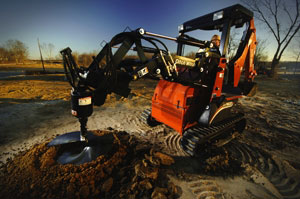Maintaining Hydraulic Health
 Your fleet is the muscle behind your business. If your iron isn’t up and working, then neither are you. That’s why constant preventative maintenance always makes sense – less downtime means more uptime, better efficiency and production and more money and success in the end.
Your fleet is the muscle behind your business. If your iron isn’t up and working, then neither are you. That’s why constant preventative maintenance always makes sense – less downtime means more uptime, better efficiency and production and more money and success in the end.
While greasing zerks, checking tire pressure, cleaning undercarriages and changing oil is pretty routine for most conscientious contractors, hydraulic maintenance is sometimes a forgotten essential.
It’s not hard to keep your equipment’s hydraulic systems healthy. Just to show you how easy it can be, here are some common causes of hydraulic system breakdown and steps you can take to avoid them.
Contamination
An estimated 75 percent of all hydraulic system failures are due to some kind of contamination, so change filters regularly. If filters become dirty too frequently, examine them. Metal shavings can indicate that a pump, motor or other upstream component may be failing. Resin or sludge-type material usually means oxidation of the fluid, which may mean that fluid levels are low or seals are damaged.
If you have to break into the hydraulic system, be sure to use clean tools and equipment and always thoroughly clean hydraulic components before you remove, repair or reinstall them. When you disconnect a hydraulic line, cap or plug the end to keep contamination out while you’re servicing the system. When you put the system back together, always install a new filter.
Low or Dirty Fluid
Low fluid levels can cause everything from sluggish cylinder operation to catastrophic pump cavitations, so check the fluid regularly (with the engine off and the fluid cool) and maintain it at correct levels. Also make sure you use the right fluid for your system.
What is your fluid telling you? Murky or cloudy fluid usually indicates water or air in the system. Water can come from condensation and excess air can be a result of low fluid levels, a damaged seal or a crack in a suction hose.
Discolored fluid or fluid with a burned smell may indicate an overheated system. Causes of overheating include a dirty or clogged fluid cooler, excessively high operating pressures, a valve stuck open with fluid constantly running through it or a leak within a pump that causes it to work harder.
Other System Components
When your hydraulic system has trouble, pinpointing the cause can be challenging, but sometimes the obvious causes get overlooked. Before you get in too deep, try these preliminary checks:
- Check the hydraulic fluid level with the engine off and the fluid cool. Also check the condition of the fluid (see above).
- With the engine stopped, check for leaks around seals, castings and hydraulic connections.
- Check for kinks in hydraulic lines that could restrict fluid flow.
- Check for a plugged or damaged fluid cooler.
- Check for a plugged or damaged fluid filter.
- Since some hydraulic valves are powered by electrical switches, check the electrical connections to these solenoid valves. The problem may not be hydraulic after all.
If these checks fail to pinpoint the trouble, it’s time to troubleshoot. Equipment repair guides, available from your equipment dealer, can help. These useful manuals contain detailed, easy-to-use troubleshooting steps.
When in doubt, you can always find factory-trained technicians at your dealership – professionals whose only business is keeping equipment healthy. For some equipment owners, this may be the most valuable repair tip of all.
Hydraulic Safety
Protecting the hydraulic health of your machines is as important as protecting the health of your employees. Before your mechanics, fleet managers or operators begin to tinker with a piece of equipment’s hydraulic system, be sure they know these safety standards:
- Always lower hydraulic attachments – such as digging booms, buckets or lift arms – to the ground before leaving the machine.
- If you must work on the system with an attachment raised, support it with blocks capable of holding its weight (check manufacturer’s specifications for weight).
- If cylinders must be removed, first make sure the attachment is resting on the ground or supported by safety stands or blocks. Turn off engine.
- Never service a hydraulic system with the machine’s engine running unless absolutely necessary.
- Before disconnecting hydraulic lines, relieve pressure in the system. Many times this can be done simply by cycling the controls. Read the instructions for your machine.
- Check hydraulic lines for frays, cracks, bubbles or other signs of damage. Replace any damaged hoses with properly rated hoses.
- When repairs are finished, check all hydraulic connections to be sure they are tight.
- When checking for leaks, do not use your hands. Always wear safety glasses and gloves and use a piece of cardboard or other heavy material. Pressurized fluid can cause serious injury.
- Do not raise relief settings to boost poor performance. If your repair didn’t bring operations back to normal, look for another cause.

Comments are closed here.